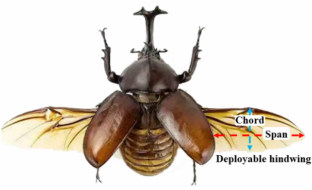Study on the Vibration Reduction Characteristics of FWMAV Flexible Bionic Wings Mimicking the Hindwings of Trypoxylus dichotomus
Abstract
Using the method of structural finite element topology optimization and analysis of the hindwings of Trypoxylus dichotomus, this work identified the main loading force transmission path and designed the initial structure of a bionic flexible wing. A structural design scheme of the vibration damping unit was proposed, and the structural mechanics and modal vibration characteristics were simulated and analyzed. 3D printing technology was used to manufacture the designed bionic wing skeleton, which was combined with two kinds of wing membrane materials. The Flapping Wing Micro-aerial Vehicle (FWMAV) transmission mechanism vibration characteristics were observed and analyzed by a high-speed digital camera. A triaxial force transducer was used to record the force vibration of the flexible bionic wing flapping in a wind tunnel. A wavelet processing method was used to process and analyze the force signal. The results showed that the force amplitude was more stable, the waveform roughness was the lowest, and the peak shaving phenomenon at the z-axis was the least obvious for the bionic flexible wing model that combined the topology-optimized bionic wing skeleton with a polyamide elastic membrane. This was determined to be the most suitable design scheme for the wings of FWMAVs.


 求助内容:
求助内容: 应助结果提醒方式:
应助结果提醒方式:


